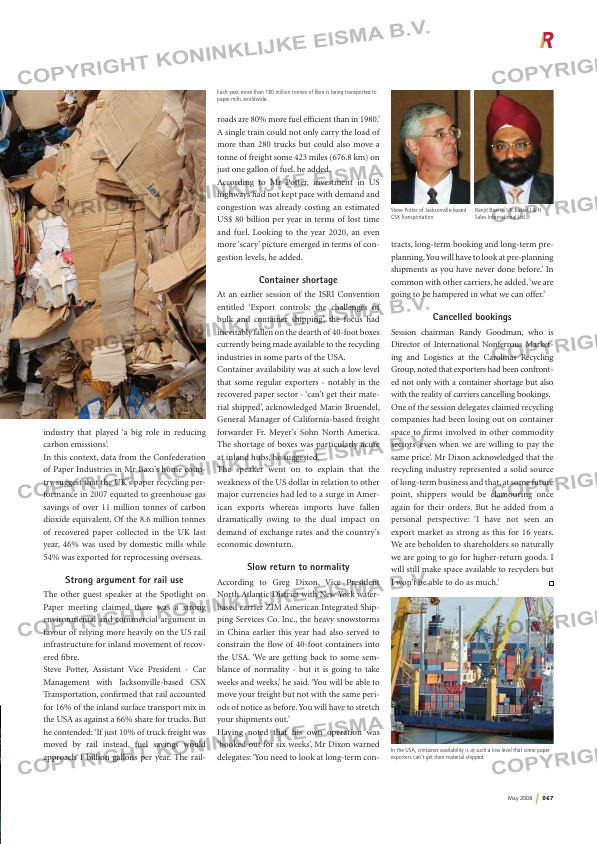Page 67 from: May 2008

May 2008 067
industry that played ‘a big role in reducing
carbon emissions’.
In this context, data from the Confederation
of Paper Industries in Mr Baxi’s home coun-
try suggest that the UK’s paper recycling per-
formance in 2007 equated to greenhouse gas
savings of over 11 million tonnes of carbon
dioxide equivalent. Of the 8.6 million tonnes
of recovered paper collected in the UK last
year, 46% was used by domestic mills while
54% was exported for reprocessing overseas.
Strong argument for rail use
The other guest speaker at the Spotlight on
Paper meeting claimed there was a strong
environmental and commercial argument in
favour of relying more heavily on the US rail
infrastructure for inland movement of recov-
ered fibre.
Steve Potter, Assistant Vice President – Car
Management with Jacksonville-based CSX
Transportation, confirmed that rail accounted
for 16% of the inland surface transport mix in
the USA as against a 66% share for trucks. But
he contended: ‘If just 10% of truck freight was
moved by rail instead, fuel savings would
approach 1 billion gallons per year. The rail-
roads are 80% more fuel efficient than in 1980.’
A single train could not only carry the load of
more than 280 trucks but could also move a
tonne of freight some 423 miles (676.8 km) on
just one gallon of fuel, he added.
According to Mr Potter, investment in US
highways had not kept pace with demand and
congestion was already costing an estimated
US$ 80 billion per year in terms of lost time
and fuel. Looking to the year 2020, an even
more ‘scary’ picture emerged in terms of con-
gestion levels, he added.
Container shortage
At an earlier session of the ISRI Convention
entitled ‘Export controls: the challenges of
bulk and container shipping’, the focus had
inevitably fallen on the dearth of 40-foot boxes
currently being made available to the recycling
industries in some parts of the USA.
Container availability was at such a low level
that some regular exporters – notably in the
recovered paper sector – ‘can’t get their mate-
rial shipped’, acknowledged Mario Bruendel,
General Manager of California-based freight
forwarder Fr. Meyer’s Sohn North America.
The shortage of boxes was particularly acute
at inland hubs, he suggested.
The speaker went on to explain that the
weakness of the US dollar in relation to other
major currencies had led to a surge in Amer-
ican exports whereas imports have fallen
dramatically owing to the dual impact on
demand of exchange rates and the country’s
economic downturn.
Slow return to normality
According to Greg Dixon, Vice President
North Atlantic District with New York water-
based carrier ZIM American Integrated Ship-
ping Services Co. Inc., the heavy snowstorms
in China earlier this year had also served to
constrain the flow of 40-foot containers into
the USA. ‘We are getting back to some sem-
blance of normality – but it is going to take
weeks and weeks,’ he said. ‘You will be able to
move your freight but not with the same peri-
ods of notice as before. You will have to stretch
your shipments out.’
Having noted that his own operation was
‘booked out for six weeks’, Mr Dixon warned
delegates: ‘You need to look at long-term con-
tracts, long-term booking and long-term pre-
planning. You will have to look at pre-planning
shipments as you have never done before.’ In
common with other carriers, he added, ‘we are
going to be hampered in what we can offer.’
Cancelled bookings
Session chairman Randy Goodman, who is
Director of International Nonferrous Market-
ing and Logistics at the Carolinas Recycling
Group, noted that exporters had been confront-
ed not only with a container shortage but also
with the reality of carriers cancelling bookings.
One of the session delegates claimed recycling
companies had been losing out on container
space to firms involved in other commodity
sectors ‘even when we are willing to pay the
same price’. Mr Dixon acknowledged that the
recycling industry represented a solid source
of long-term business and that, at some future
point, shippers would be clamouring once
again for their orders. But he added from a
personal perspective: ‘I have not seen an
export market as strong as this for 16 years.
We are beholden to shareholders so naturally
we are going to go for higher-return goods. I
will still make space available to recyclers but
I won’t be able to do as much.’
Steve Potter of Jacksonville-based
CSX Transportation
Ranjit Baxi of UK-based J & H
Sales International Ltd.
Each year, more than 180 million tonnes of fibre is being transported to
paper mills worldwide.
In the USA, container availability is at such a low level that some paper
exporters can’t get their material shipped.
RI_041_ISRI Paper.indd 3 14-05-2008 13:59:32



